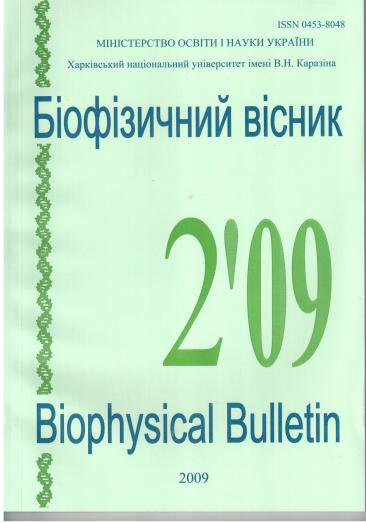Actinocin derivative interaction with DNA molecules at different concentrations of monovalent alkaline metals ions Na+ and K+
Abstract
Spectrophotometric titration method is used to study the actinomycin derivative ActII*, an analog of the
actinomycin D, interaction with calf thymus DNA. Models of several types of complexes forming between
ligand and polynucleotide matrix are considered. DALSMOD optimization program of spectrophotometric
concentration dependencies are used to choose the optimal complexation model. The results of the calculation are evidence of the three different spectral types of complexes in the system Act II* -DNA. Na+and K+ions are considered as competitors of the ligand by one of the binding sites. Logarithms of binding constants of each type of complexes depend linearly on the logarithm of NaCl and KCl concentrations in the considered interval. The slopes of these dependencies are different for Na+and K+ions.
Downloads
References
2. Denisov V.P. and Halle B. // Proc. Natl. Acad. Sci. USA., Vol. 97, 2000, P. 629-633.
3. Zinchenko A.A. and Kenichi Yoshikawa // Biophys. J., Vol.88, 2005, P. 4116-4123.
4. Ross P.D., Scruggs R.L. // Biopolymers, Vol. 2, 1964, P. 79-89.
5. Strauss U.P., Helfgott C., Pink H. // J.Phys.Chem.,Vol. 71, 1967, P. 2550-2556.
6. Hanlon S. et. al. // Biochemistry, Vol. 14, 1975, P. 1648-1660.
7. Anderson P., Bauer W.// Biochemistry, Vol. 17, 1978, P. 594-601.
8. Bleam M.L., Anderson C.F., Record M.T. // Proc.Natl.Acad.Sci USA, Vol. 77, 1980, P.3085-3089.
9. Kuznetsov I.A. et al // Reactive Polymers, Vol. 3, 1984, P. 37.
10. Круглова Е.Б. и др. // Біофизичний вісник. 1(10), 2002, с. 12-20.
11. Karapetian A.T. et. al. // J. Biomol. Struct. Dyn. Vol. 8. № 1, 1990, P. 123-130.
12. Tuite E., Norden B. // J. Am. Chem. Soc., Vol. 116, 1994, P. 7548-7556.
13. Kubota Y. // Bull. Chem. Soc. Japan., vol. 46, 1973, P. 2630-2633.
14. Sovenhasy K.M. // Nucleic Acids Research, Vol. 31, 2003, P. 2561-2569.
15. Scatchard G.// Ann. N.Y. Acad. Sci., Vol. 51, 1949, P. 660-672.
16. McGhee J.D., von Hippel P.H. // J. Mol. Biol., Vol. 86, 1974, P. 469-489.
17. Нечипуренко Ю.Д. // Мол. Биология, 18, 1984, c.1066-1080.
18. Anticancer Drug Desing. // By eds. Veselkov A.N., Davies D.B.: SEVNTU PRESS. 2002. 259 p.
19. Tereshko et. al. // Nucleic Acids Research, Vol.29, 2001, P. 1208-1215.
20. Varnai P., Zakrzewska K. // Nucleic Acids Research, Vol. 32, 2004, P. 4269–4280.
21. Cheng Yu., Korolev N. and Nordenskiold L. //Nucleic Acids Research, Vol. 34, 2006, P. 686-696.
22. Кривцова М.А., Морошкина Е.Б. и др. // Мол.Биология, 16(1), 1982, с.149-155.
23. Muller W., Crothers D.M.// Eur.J.Biochem, V.54, 1975, P. 267-277.
24. Круглова Е.Б. // Біофизичний вісник. 1(8), 2001, c. 27 - 41.
25. Нечипуренко Ю.Д., Гурский Г.В. // Биофизика 48, 2003, c. 773-796.
26. Solution equlibria. Hartley F., Burgess C., Alcock R. // Ellis Horwood. 1980. 360 p.
27. Круглова Е.Б. и др. // Биофизика 50 (2), 2005, c. 243-254.
28. Shigeori Takenaka, et. al. // Analytical Sciences Vol.13, supplement 1997, P. 303-305.
29. Vardevanyan P .O. et. al. // Experimental and Molecular medicine, Vol. 35, 2003, P. 527-533.
30. Toshihiro Ihara et. al. // Nucleic Acids Research Supplement № 3, 2003, P. 85-86.
31. Sanders K. J., Wiles H., and Rodger A. // The Analyst, Vol. 126, 2001, P. 852-854.
32. Trieb M. et. al. // Nucleic Acids Research, Vol. 32, 2004, P. 4696–4703.
33. Круглова Е.Б. и др. // Биополимеры и клетка 21 (4) , 2005, с. 358-364.
Authors who publish with this journal agree to the following terms:
- Authors retain copyright and grant the journal right of first publication with the work simultaneously licensed under a Creative Commons Attribution License that allows others to share the work with an acknowledgement of the work's authorship and initial publication in this journal.
- Authors are able to enter into separate, additional contractual arrangements for the non-exclusive distribution of the journal's published version of the work (e.g., post it to an institutional repository or publish it in a book), with an acknowledgement of its initial publication in this journal.
- Authors are permitted and encouraged to post their work online (e.g., in institutional repositories or on their website) prior to and during the submission process, as it can lead to productive exchanges, as well as earlier and greater citation of published work (See The Effect of Open Access).





